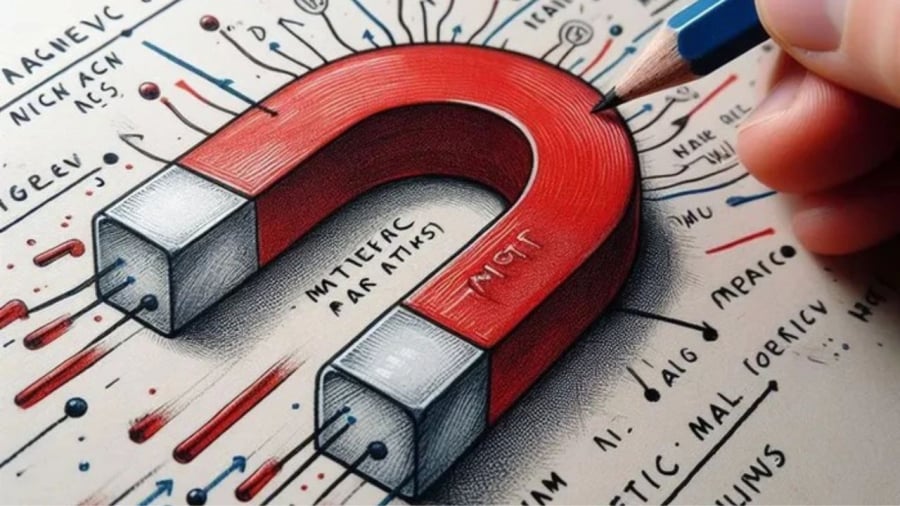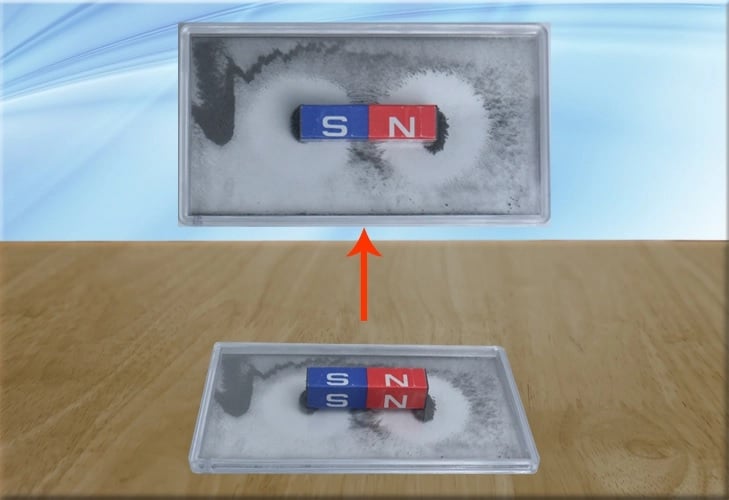Your small magnet is attracted to the Earth’s core, so it always points North. That’s the rule a magnet follows, it always points in a certain direction. If you hold two magnets in the wrong direction towards each other, they will repel each other. In other words, if you hold two magnets with the same North or South pole together, they will push each other away.

What are magnets made of?
To answer this question, we first need to understand what magnets are made of. All matter, including magnets, is made up of atoms. In every atom, the nucleus is surrounded by one or more electrons with a negative charge. Each electron creates its own very small magnetic field, which scientists call “spin”. If the magnetic field is tiny enough and points in the same direction, the material itself becomes magnetic.
“Spin” of an electron is an abstract concept. Technically, no one has ever seen the spin of an electron – it’s too small to be visible under a microscope. But physicists know that electrons have magnetic fields because they have measured them. One way this field is created is by electrons spinning.
When possible, electrons pair up so their spins cancel each other out, making the total magnetism of the atom equal to 0. But in some elements, like iron, this doesn’t happen. The number of electrons and how they position themselves around the nucleus can result in each iron atom having one unpaired electron, creating a small magnetic field.
In non-magnetized materials, these individual tiny magnetic fields point in random directions. In this state, they almost cancel each other out, so the overall material has no magnetism. But under certain conditions, the tiny magnetic fields of the atoms can align and point in the same direction. These small magnetic fields combine to create larger magnetic fields, making the iron material magnetic.
Using magnets
Many magnets are used in everyday life, such as refrigerator magnets which are permanent magnets. In these materials, the magnetic fields of many atoms within the material have been permanently linked by some external force – as if they were placed in a stronger magnetic field.
Usually, a stronger magnetic field is created using electricity. Electricity and magnetism are fundamentally linked because magnetic fields are created by the movement of charges. That’s why electrons spinning have magnetic fields, but scientists can also use electricity to create extremely strong magnets. Running enough electrical current through a coil of wire will create a very strong magnetic field that lasts as long as the current is running. These electromagnets are often used in physics research. They are also used in medical tools like Magnetic Resonance Imaging (MRI) machines.
Why do magnets have only 2 poles – North and South?
Earth itself has its own magnetic field – this is how compasses work. Scientists define the North Pole of the magnet as the point on the magnet that would point toward the Earth’s North Pole if the magnet was free to rotate. But technically, this means that the magnet’s North pole is actually a South pole because opposite poles attract each other.
In the physics convention, the lines of force run from the North pole of the magnet and go into its South pole, forming a closed loop. You can observe this phenomenon by performing a simple experiment using some small iron filings and a magnet. Place the magnet on a piece of paper and sprinkle some iron filings onto the paper. You will see the iron filings align along the lines of force, forming a pattern. This is a visualization of the magnet’s magnetic field.

Physicists have also discovered other arrangements of magnetic poles, including quadrupole poles, where the combination of North and South poles is arranged in a square pattern. But one elusive target is single magnetic poles.
Electrons and protons are elementary particles, and they both carry positive or negative charge. But electrons (and other particles) have two magnetic poles. Being fundamental particles, they cannot be further divided. The difference in how particles behave electrically and magnetically has intrigued many physicists. Its discovery would challenge the laws of physics as we currently understand them.
Magnets are one of the deepest mysteries of physics, and although humans have been using them for thousands of years, scientists are still discovering new things about how they work. Perhaps one day we will unravel all their secrets.
































